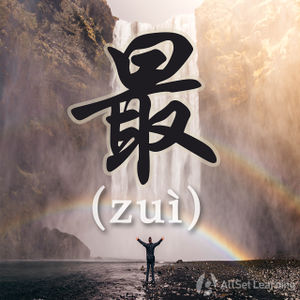Difference between revisions of "Superlative "zui""
(→Books) |
|||
| Line 55: | Line 55: | ||
* [[New Practical Chinese Reader 3 (新实用汉语课本3)]] (pp. 15-6) [http://www.amazon.com/gp/product/756191251X/ref%3das_li_ss_tl?ie=UTF8&tag=allset-20&linkCode=as2&camp=217145&creative=399369&creativeASIN=756191251X →buy] | * [[New Practical Chinese Reader 3 (新实用汉语课本3)]] (pp. 15-6) [http://www.amazon.com/gp/product/756191251X/ref%3das_li_ss_tl?ie=UTF8&tag=allset-20&linkCode=as2&camp=217145&creative=399369&creativeASIN=756191251X →buy] | ||
| + | * [[Mandarin Chinese: A Functional Reference Grammar)]] (pp. 571-74) [http://www.amazon.com/Mandarin-Chinese-Functional-Reference-Grammar/dp/0520066103 →buy] | ||
[[Category:B1 grammar points]] | [[Category:B1 grammar points]] | ||
Revision as of 06:48, 13 September 2012
-
Level
-
Similar to
-
Used for
-
Keywords
The most common way to form a superlative (best, worst, thinnest, fattest etc.) in Chinese is to use 最 (zuì).
Contents
Basic Structure
The structure is:
最 + Adjective
And now you have the superlative form of the adjective. Unlike in English, this structure is consistent for all adjectives in Chinese.
Examples
- 他 最 笨。
- 你 最 胖。
- 我 最 矮。
Optional 了
Occasionally you'll also see a 了 added after the adjective. This just adds emphasis to the "-est."
最 + Adjective + 了
Examples
- 他 最 聪明 了。
- 你 最 瘦 了。
- 我 最 高 了。
See also
- Expressing "excessively" with tai
- Positive adjectives with "-ji le"
- Expressing "rather" with "bijiao"
Sources and further reading
Books
- New Practical Chinese Reader 3 (新实用汉语课本3) (pp. 15-6) →buy
- Mandarin Chinese: A Functional Reference Grammar) (pp. 571-74) →buy



